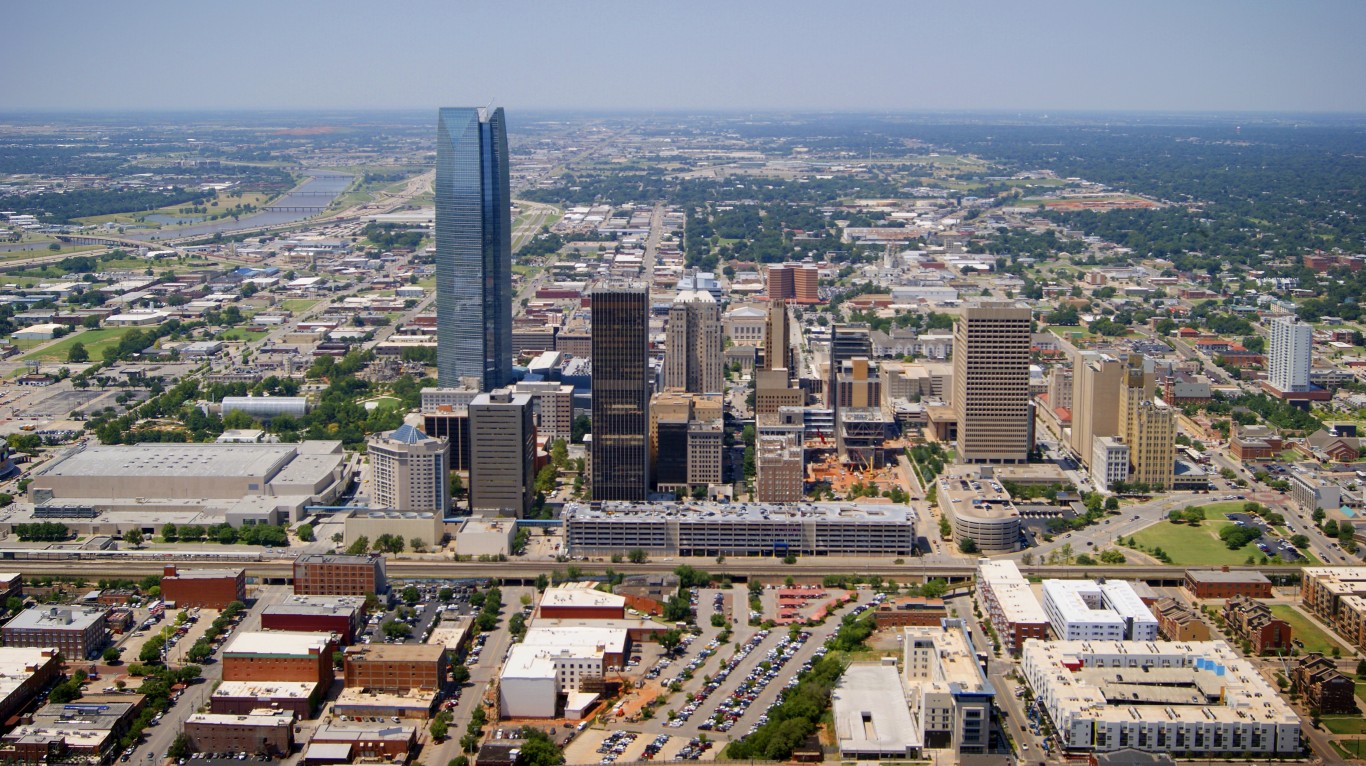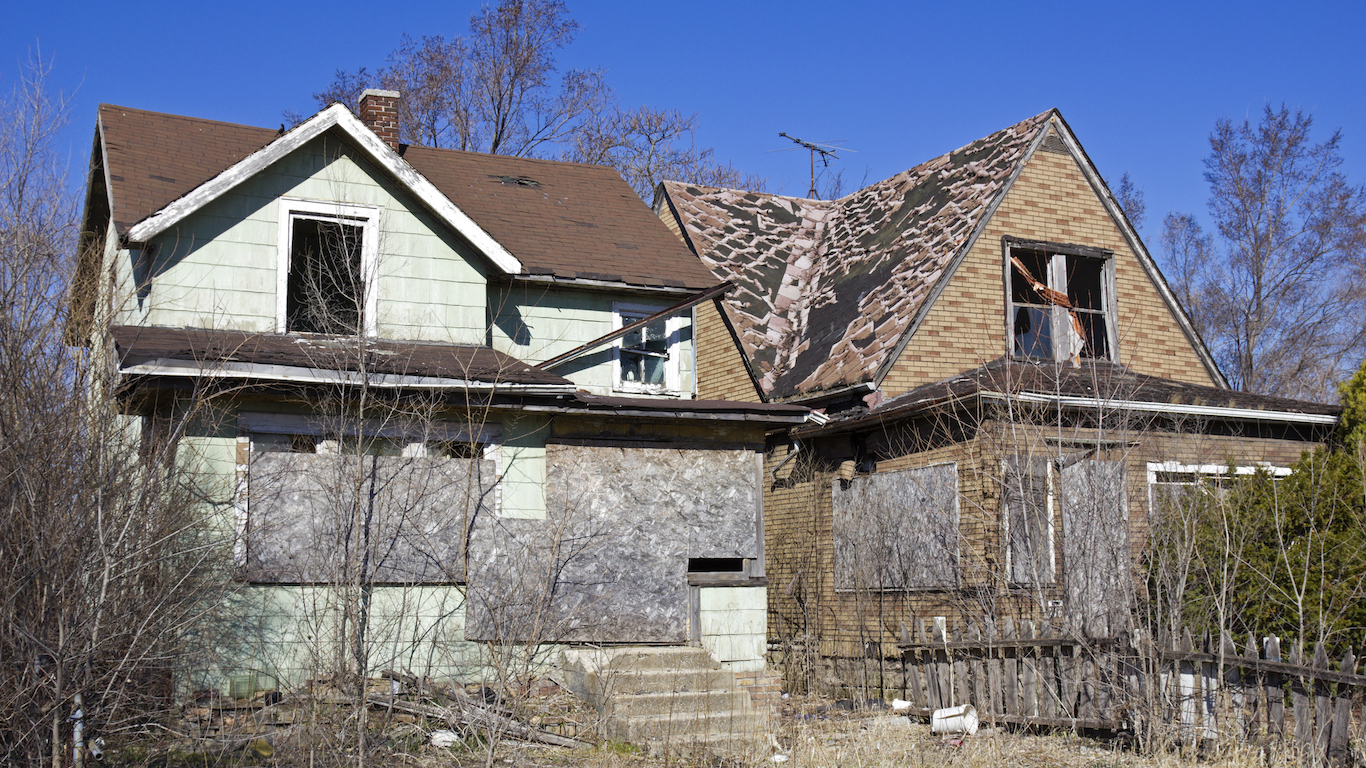
Prior to the COVID-19 pandemic, American households were earning more than they ever had before. The median household income in 2019 was $65,712, up from $62,860 the previous year — a 4.5% increase. Though nearly every state reported an increase in its median household income, the percentage increases in some states were nearly double the U.S. increase.
24/7 Wall St. reviewed data on each state’s change in median household income from 2018 to 2019 to determine the states where incomes have increased the most. Income data, as well as data on the poverty rate, came from the U.S. Census Bureau’s 2019 American Community Survey. Data annual unemployment rates came from the Bureau of Labor Statistics. In 10 states, the changes recorded were not considered statistically significant, and those states were omitted from the list.
The states where incomes have increased the most were not clustered in one area, and both wealthier and poorer states had some of the largest increases. In a dozen states, incomes increased by more than 5% from 2018 to 2019. Five had higher incomes than the U.S. median of $65,712, while seven had lower incomes.
None of the 12 states with the largest increases in median household income is a Midwestern state, while five are Southern, five are Western, and two are located in the Northeast. Of the seven states in which incomes increased by less than 3%, four are in the South and three are in the Midwest.
The current U.S. economy is very different than it was in 2019 largely because of the turmoil caused by the COVID-19 pandemic. Millions of Americans lost their jobs and filed for unemployment benefits. Though the unemployment rate has started to decline, experts are concerned about a resurgence of the virus in the fall that could lead to unemployment to rise again. These are the states where the spread of the virus is slowing and where it is getting worse.
Click here to see the states where incomes have gone up the most.

40. Indiana
> 1 yr. change in median household income: +1.8%
> Median household income: $57,603 (2019); $56,583 (2018)
> Poverty rate: 11.9% (2019); 13.1% (2018)
> Unemployment: 3.3% (2019); 3.5% (2018)
The typical Indiana household earned $57,603 in 2019, a modest 1.8% increase from the previous year. The state was one of 40 nationwide to report a statistically significant increase in household income in 2019. The increase was less than half the national average increase of 4.5%. Over the same period, the median household income nationwide climbed from $62,860 to $65,712.
The rise in incomes in Indiana resulted in a decline in the state’s poverty rate, from 13.1% in 2018 to 11.9% in 2019.
[in-text-ad]

39. Maryland
> 1 yr. change in median household income: +2.2%
> Median household income: $86,738 (2019); $84,845 (2018)
> Poverty rate: 9.0% (2019); 9.0% (2018)
> Unemployment: 3.6% (2019); 3.9% (2018)
The median household income in Maryland increased by just 2.2% from 2018 to 2019, less than half of the 4.5% increase in the overall U.S. median household income in that time. Despite the lower increase, the state still has the highest median household income of any state at $86,738, more than $20,000 higher than the U.S. median for 2019.
Maryland’s income growth did not result in a change in the poverty rate, which stayed at 9.0% — the fourth lowest poverty rate among states and well below the 13.1% national rate.

38. Arkansas
> 1 yr. change in median household income: +2.4%
> Median household income: $48,952 (2019); $47,787 (2018)
> Poverty rate: 16.2% (2019); 17.2% (2018)
> Unemployment: 3.5% (2019); 3.6% (2018)
Arkansas is one of the poorest states in the country, with a median annual household income of $48,952. Though the state reported a 2.4% gain in median income in 2019, the increase was relatively modest compared to that of most states.
Still, Arkansas reported a sharper decline in poverty than most other states. The statewide poverty rate fell from 17.2% to 16.2% between 2018 and 2019, making Arkansas one of 17 states where poverty fell by at least a full percentage point.

37. Alabama
> 1 yr. change in median household income: +2.6%
> Median household income: $51,734 (2019); $50,447 (2018)
> Poverty rate: 15.5% (2019); 16.8% (2018)
> Unemployment: 3.0% (2019); 3.9% (2018)
The typical Alabama household made about $1,300 more in 2019 than in 2018 — a relatively low 2.6% increase. The higher median income in the state was likely driven in part by the improved job market. An average of only 3.0% of the labor force in Alabama was unemployed in 2019, down from 3.9% in 2018.
Educational attainment rates also rose in Alabama over the same period. Of all adults 25 and older in the state in 2018, 25.5% had a bachelor’s degree. As of 2019, the share among the same age group rose to 26.3%.
[in-text-ad-2]

36. Kentucky
> 1 yr. change in median household income: +2.8%
> Median household income: $52,295 (2019); $50,889 (2018)
> Poverty rate: 16.3% (2019); 16.9% (2018)
> Unemployment: 4.3% (2019); 4.3% (2018)
The 2019 median household income in Kentucky was $52,295, 2.8% higher than the year before. In spite of this increase, Kentucky still had a lower median household income than all but six other states, well behind the $65,712 U.S. median.
As the typical Kentucky household earned more in 2019 than it did the year before, fewer households reported incomes below the poverty line as well and the state’s poverty rate dropped slightly from 16.9% to 16.3%. Still, this remained well above the 12.3% U.S. poverty rate.

35. Pennsylvania
> 1 yr. change in median household income: +2.8%
> Median household income: $63,463 (2019); $61,713 (2018)
> Poverty rate: 12.0% (2019); 12.2% (2018)
> Unemployment: 4.4% (2019); 4.2% (2018)
The typical household in Pennsylvania earned $63,463 in 2019, or $1,750 more than the median household income in 2018. The state is one of only a handful to report an increase in median income while also reporting a worse job market. Pennsylvania’s unemployment rate climbed to an average of 4.4% in 2019 from 4.2% in 2018.
[in-text-ad]

34. Ohio
> 1 yr. change in median household income: +2.9%
> Median household income: $58,642 (2019); $56,990 (2018)
> Poverty rate: 13.1% (2019); 13.9% (2018)
> Unemployment: 4.1% (2019); 4.5% (2018)
The 2.9% increase in median household income in Ohio in 2019 was smaller than the increase most states reported, and well below the 4.5% increase across the U.S. as a whole. With rising incomes, the share of Ohio residents living below the poverty line fell in the last year. In 2019, 13.1% of the state population lived below the poverty line, compared to 13.9% the previous year.

33. Arizona
> 1 yr. change in median household income: +3.0%
> Median household income: $62,055 (2019); $60,236 (2018)
> Poverty rate: 13.5% (2019); 14.0% (2018)
> Unemployment: 4.7% (2019); 4.7% (2018)
Though the median household income in Arizona increased by 3.0% from 2018 to 2019, up to over $62,000, the unemployment rate remained unchanged at 4.7% in 2019, the same as it was the year before.
Arizona also reported an increase in the share of wealthy households, with the percentage of households earning $200,000 or more per year growing from 6.1% to 6.6%. Meanwhile, the poverty rate declined by half a percentage point, though it remains higher than the 12.3% U.S. poverty rate.

32. New Jersey
> 1 yr. change in median household income: +3.1%
> Median household income: $85,751 (2019); $83,206 (2018)
> Poverty rate: 9.2% (2019); 9.5% (2018)
> Unemployment: 3.6% (2019); 4.1% (2018)
New Jersey is one of the wealthiest states in the country, with a median annual household income of $85,751. The Garden State’s median household income climbed by 3.1% in 2019. Over the same period, the share of households earning $200,000 or more annually climbed from 14.4% to 15.2%.
An improved job market may partially explain the increase in household income in New Jersey. The state unemployment rate stood at 3.6% in 2019, an improvement from the 4.1% rate in 2018.
[in-text-ad-2]

31. Virginia
> 1 yr. change in median household income: +3.4%
> Median household income: $76,456 (2019); $73,955 (2018)
> Poverty rate: 9.9% (2019); 10.7% (2018)
> Unemployment: 2.8% (2019); 3.0% (2018)
The typical Virginia household earned $76,456 in 2019, about $2,500, or 3.4%, more than in 2018. Over the same period, the share of high-income households climbed, while the share of residents facing serious financial hardship declined. The share of households earning $200,000 or more increased from 11.1% 2018 to 11.9% in 2019, and the poverty rate fell from 10.7% to 9.9%.

30. Oklahoma
> 1 yr. change in median household income: +3.4%
> Median household income: $54,449 (2019); $52,654 (2018)
> Poverty rate: 15.2% (2019); 15.6% (2018)
> Unemployment: 3.3% (2019); 3.4% (2018)
The typical Oklahoma household earned about $2,200 — or 3.4% — more in 2019 than it did the previous year. Still, the state’s income growth lagged behind that of the nation. The U.S. median household income increased by 4.5%, up to $65,712. Oklahoma’s median is over $11,000 lower, at $54,449. Across the country, only seven states have lower median household incomes than Oklahoma.
[in-text-ad]

29. Michigan
> 1 yr. change in median household income: +3.6%
> Median household income: $59,584 (2019); $57,518 (2018)
> Poverty rate: 13.0% (2019); 14.1% (2018)
> Unemployment: 4.1% (2019); 4.1% (2018)
Michigan’s average annual unemployment rate remained unchanged from 2018 to 2019, at 4.1%, even as unemployment nationwide fell from 3.9% to 3.7%. Despite a static job market, incomes in the state increased in 2019. The typical household in the state earned $59,584 in 2019, a 3.6% increase from 2018. Over the same period, the share of state residents living below the poverty line fell from 14.1% to 13.0%.

28. Georgia
> 1 yr. change in median household income: +3.6%
> Median household income: $61,980 (2019); $59,803 (2018)
> Poverty rate: 13.3% (2019); 14.3% (2018)
> Unemployment: 3.4% (2019); 3.9% (2018)
Georgia’s median household income grew from less than $60,000 in 2018 to nearly $62,000 in 2019, a 3.6% increase. The state also improved in several other economic indicators. The poverty rate declined a full percentage point to 13.3%, and the unemployment rate declined half a percentage point to 3.4%.

27. Missouri
> 1 yr. change in median household income: +3.7%
> Median household income: $57,409 (2019); $55,371 (2018)
> Poverty rate: 12.9% (2019); 13.2% (2018)
> Unemployment: 3.3% (2019); 3.2% (2018)
The typical Missouri household earned $57,409 in 2019, a modest 3.7% increase over the median household income the previous year.
Missouri is one of only a handful of states to rank on this list despite a worsening job market. The state’s unemployment rate climbed slightly from 3.2% in 2018 to 3.3% in 2019. Still, Missouri had a lower than average unemployment rate last year, as the national rate stood at 3.7%.
[in-text-ad-2]

26. Oregon
> 1 yr. change in median household income: +3.9%
> Median household income: $67,058 (2019); $64,520 (2018)
> Poverty rate: 11.4% (2019); 12.6% (2018)
> Unemployment: 3.7% (2019); 4.1% (2018)
The typical household in Oregon earned $67,058 in 2019, about $2,500, or 3.9%, more than in 2018. Rising incomes have led to a meaningful improvement in Oregon’s poverty rate. The share of state residents living below the poverty line fell from 12.6% to 11.4% between 2018 and 2019, making Oregon one of only 13 states with a poverty rate that fell by over 1 percentage points last year.

25. Maine
> 1 yr. change in median household income: +4.3%
> Median household income: $58,924 (2019); $56,513 (2018)
> Poverty rate: 10.9% (2019); 11.6% (2018)
> Unemployment: 3.0% (2019); 3.2% (2018)
Maine is one of 25 states where the annual income of the typical household climbed by over 4% in 2019. The median household income in Maine was $58,924 in 2019, about $2,400 more than in 2018.
Over the same period, the state reported an increase in especially high-earning households. In 2019, 5.2% of households in Maine earned $200,000 or more annually, up from 4.5% in 2018.
[in-text-ad]

24. Wisconsin
> 1 yr. change in median household income: +4.3%
> Median household income: $64,168 (2019); $61,521 (2018)
> Poverty rate: 10.4% (2019); 11.0% (2018)
> Unemployment: 3.3% (2019); 3.0% (2018)
Though the U.S. unemployment rate declined slightly last year, from 3.9% in 2018 to 3.7% in 2019, Wisconsin’s jobless rate increased. The state’s unemployment rate rose from 3.0% to 3.3%.
Even though a growing share of Wisconsin’s labor force reported being out of work in 2019, incomes still increased in the state. The typical household earned over $2,600 more in 2019 than it did the year before, a 4.3% increase.

23. New York
> 1 yr. change in median household income: +4.3%
> Median household income: $72,108 (2019); $69,110 (2018)
> Poverty rate: 13.0% (2019); 13.6% (2018)
> Unemployment: 4.0% (2019); 4.1% (2018)
The median household income in New York climbed by 4.3% in 2019 — a higher increase than in most states but slightly lower than the national increase in median household income of 4.5%. The median income rose in the state despite a negligible improvement in the unemployment rate. Throughout 2019, an average of 4.0% of the labor force in the state was unemployed, compared to 4.1% in 2018.

22. Texas
> 1 yr. change in median household income: +4.4%
> Median household income: $64,034 (2019); $61,355 (2018)
> Poverty rate: 13.6% (2019); 14.9% (2018)
> Unemployment: 3.5% (2019); 3.8% (2018)
Texas ranked 24th of all states in 2018 with a median household income of $61,355. A year later, it ranked 22nd, as the typical household in the state earned more than $64,000 in 2019. Though the state also had a relatively large 1.3 percentage point decline in the poverty rate, down to 13.6%, it remained well above the 12.3% nationwide poverty rate.
[in-text-ad-2]

21. South Dakota
> 1 yr. change in median household income: +4.4%
> Median household income: $59,533 (2019); $57,030 (2018)
> Poverty rate: 11.9% (2019); 13.1% (2018)
> Unemployment: 3.3% (2019); 3.1% (2018)
The median household income in South Dakota climbed by about $2,500 from 2018 to 2019. The 4.4% increase was higher than in most other states and nearly in line with the 4.5% increase nationwide. The median household income climbed in the state even as the unemployment rate increased. The annual unemployment rate stood at 3.3% in South Dakota in 2019, up from 3.1% in 2018. Still, South Dakota residents are less likely to be out of work than most Americans, as the annual unemployment rate stands at 3.7% nationwide.

20. Minnesota
> 1 yr. change in median household income: +4.5%
> Median household income: $74,593 (2019); $71,394 (2018)
> Poverty rate: 9.0% (2019); 9.6% (2018)
> Unemployment: 3.2% (2019); 2.9% (2018)
Between 2018 and 2019, the median household income in Minnesota climbed from $71,394 to $74,593. The 4.5% increase was higher than the increase most states reported and in line with the comparable increase across all households nationwide.
Unlike most states on this list, Minnesota’s unemployment rate increased between 2018 and 2019, from 2.9% to 3.2%. Of the six states on this list that had higher unemployment in 2019 than in 2018, Minnesota reported one of the largest increases in median household income — and one of the largest increases in unemployment.
[in-text-ad]

19. Nebraska
> 1 yr. change in median household income: +4.5%
> Median household income: $63,229 (2019); $60,490 (2018)
> Poverty rate: 9.9% (2019); 11.0% (2018)
> Unemployment: 3.0% (2019); 2.9% (2018)
The typical household in Nebraska earned $63,229 in 2019, about $2,700 more than in 2018. The higher incomes led to a significant reduction in the share of state residents facing serious financial hardship. The poverty rate in Nebraska fell from 11.0% in 2018 to 9.9% in 2019, one of the larger improvements among states. Despite reporting a rise in incomes, Nebraska is one of only six states where unemployment was worse in 2019 than in 2018, as the unemployment rate ticked up from 2.9% to 3.0% over that period.

18. Utah
> 1 yr. change in median household income: +4.5%
> Median household income: $75,780 (2019); $72,484 (2018)
> Poverty rate: 8.9% (2019); 9.0% (2018)
> Unemployment: 2.6% (2019); 3.0% (2018)
Median household income climbed by 4.5% in Utah from 2018 to 2019, in line with the increase nationwide. Though household incomes are climbing at comparable rates, the median household income in Utah, at $75,780, is about $10,000 greater than the national median.
The high — and rising — median household income in Utah is likely due in part to the strong job market in the state. Just 2.6% of the state’s labor force was out of work in 2019, down from 3.0% in 2018. Over the same period, the national unemployment rate fell to 3.7% from 3.9%.

17. Washington
> 1 yr. change in median household income: +4.6%
> Median household income: $78,687 (2019); $75,231 (2018)
> Poverty rate: 9.8% (2019); 10.3% (2018)
> Unemployment: 4.3% (2019); 4.5% (2018)
The median household income in Washington climbed by 4.6% in 2019 — from $75,231, to $78,687. Over the same period, the median household income nationwide increased by 4.5%. In the majority of states that reported stronger than average income growth, incomes remain lower than they are nationwide. Washington is one of the exceptions, however, as the typical household earns about $13,000 more annually than the typical American household does.
[in-text-ad-2]

16. North Carolina
> 1 yr. change in median household income: +4.7%
> Median household income: $57,341 (2019); $54,756 (2018)
> Poverty rate: 13.6% (2019); 14.0% (2018)
> Unemployment: 3.9% (2019); 4.0% (2018)
Median household income climbed by 4.7% in North Carolina in 2019 — a slightly larger increase than the 4.5% increase across the U.S. as a whole. Despite outpacing national income growth, the typical North Carolina household earns $57,341 a year, about $8,000 less than the typical American household.
North Carolina residents are also more likely than most Americans to struggle financially. The state poverty rate stands at 13.6%, down from 14.0% in 2018. Over the same period, the national poverty rate fell to 12.3% from 13.1%.

15. Kansas
> 1 yr. change in median household income: +4.8%
> Median household income: $62,087 (2019); $59,224 (2018)
> Poverty rate: 11.4% (2019); 12.0% (2018)
> Unemployment: 3.2% (2019); 3.3% (2018)
The typical Kansas household earns $62,087 a year — nearly $3,000 more than in the previous year. The state is also home to a larger share of high income households than in 2018. As of 2019, 5.9% of Kansas households earned $200,000 or more per year, up from 5.4% in 2018.
Many states that reported a higher than average increase in household income also had steep reductions in unemployment. In Kansas, the job market improvement was relatively modest, however, falling from 3.3% in 2018 to 3.2% in 2019.
[in-text-ad]

14. Louisiana
> 1 yr. change in median household income: +4.9%
> Median household income: $51,073 (2019); $48,694 (2018)
> Poverty rate: 19.0% (2019); 18.6% (2018)
> Unemployment: 4.8% (2019); 4.9% (2018)
With its median household income growing by 4.9%, Louisiana is one of 18 states with a greater income growth than the 4.5% U.S. growth. Despite the income increase, Louisiana households have among the lowest incomes of any state. The median household income of just over $51,000 is the fourth lowest of any state and nearly $15,000 lower than the U.S. median. Louisiana’s poverty rate of 19.0% is the second highest among states. For comparison, the U.S. poverty rate is 12.3%.

13. Illinois
> 1 yr. change in median household income: +4.9%
> Median household income: $69,187 (2019); $65,962 (2018)
> Poverty rate: 11.5% (2019); 12.1% (2018)
> Unemployment: 4.0% (2019); 4.3% (2018)
From 2018 to 2019, the median household income in Illinois increased by more than $3,000 to over $69,000 — well beyond the U.S. median household income of $65,712. Illinois also has an 11.5% poverty rate, as compared to the nationwide poverty rate of 12.3%.
Workers with a college degree tend to earn higher incomes than workers with lower levels of education. Illinois has the country’s 12th highest bachelor’s degree attainment rate, at 35.8%, likely contributing to the relatively high incomes in the state.

12. Florida
> 1 yr. change in median household income: +5.2%
> Median household income: $59,227 (2019); $56,292 (2018)
> Poverty rate: 12.7% (2019); 13.6% (2018)
> Unemployment: 3.1% (2019); 3.6% (2018)
Median household income in Florida climbed by 5.2% — or nearly $3,000 — from 2018 to 2019. Over the same period, the state’s poverty rate fell by nearly a full percentage point — from 13.6% to 12.7%. Similarly, the share of high-earning Florida households increased last year. In 2018, 6.2% of households in the state earned $200,000 or more. As of 2019, 6.7% of households earned at least $200,000.
[in-text-ad-2]

11. Tennessee
> 1 yr. change in median household income: +5.3%
> Median household income: $56,071 (2019); $53,274 (2018)
> Poverty rate: 13.9% (2019); 15.3% (2018)
> Unemployment: 3.4% (2019); 3.5% (2018)
The typical Tennessee household earned $56,071 in 2019, or 5.3% more than the previous year. The increase has had a meaningful impact on the state’s poverty rate. As of 2019, the share of Tennessee residents living below the poverty line stood at 13.9%, down from 15.3% in 2018. The year-over-year 1.4 percentage point decrease in poverty was the fourth largest of any state.

10. California
> 1 yr. change in median household income: +5.3%
> Median household income: $80,440 (2019); $76,418 (2018)
> Poverty rate: 11.8% (2019); 12.8% (2018)
> Unemployment: 4.0% (2019); 4.3% (2018)
Median household income increased by 5.3% in California between 2018 and 2019. In many of the states that reported substantial increases in median income over that period, the typical household earns less than the typical American household. This is not the case in California, however. The typical household in the state earns $80,440 a year, about $15,000 more than the median household income across the U.S. as a whole.
[in-text-ad]

9. Colorado
> 1 yr. change in median household income: +5.5%
> Median household income: $77,127 (2019); $73,140 (2018)
> Poverty rate: 9.3% (2019); 9.6% (2018)
> Unemployment: 2.8% (2019); 3.2% (2018)
Colorado had one of the strongest job markets in the country in 2018 with an average unemployment rate of just 3.2% — well below the 3.9% national rate. Joblessness was even less common in 2019, when an average of only 2.8% of the state’s labor force out of work. The improving job market may have helped drive Colorado’s median household income up by 5.5%, from $73,140 in 2018, to $77,127 in 2019.

8. South Carolina
> 1 yr. change in median household income: +5.6%
> Median household income: $56,227 (2019); $53,222 (2018)
> Poverty rate: 13.8% (2019); 15.3% (2018)
> Unemployment: 2.8% (2019); 3.5% (2018)
In 2018, South Carolina had the ninth lowest median household income of any state, at $53,222. However, in 2019, incomes in the state climbed by 5.6% — far faster than the national 4.5% increase. Now South Carolina’s median household income stands at $56,227, the 10th lowest in the country.
The income increase was likely due in part to an improved job market. The average unemployment rate in South Carolina in 2019 was just 2.8%, a considerable improvement from the 3.5% jobless rate in 2018.

7. Nevada
> 1 yr. change in median household income: +5.9%
> Median household income: $63,276 (2019); $59,737 (2018)
> Poverty rate: 12.5% (2019); 12.9% (2018)
> Unemployment: 3.9% (2019); 4.4% (2018)
The typical Nevada household earned $63,276 in 2019, about $3,500 more than in 2018. The 5.9% increase in median income was higher than in all but six other states. As is often the case in states where incomes rose rapidly from 2018 to 2019, Nevada also reported an improved job market over the same period. The average unemployment rate in the state in 2019 was 3.9%, down from 4.4% the previous year.
[in-text-ad-2]

6. Massachusetts
> 1 yr. change in median household income: +6.0%
> Median household income: $85,843 (2019); $80,976 (2018)
> Poverty rate: 9.4% (2019); 10.0% (2018)
> Unemployment: 2.9% (2019); 3.4% (2018)
The median household income in Massachusetts increased by 6.0% from 2018 to 2019 to nearly $86,000 — the second highest median household income among states, behind only Maryland.
College-educated workers tend to make more than other workers, and Massachusetts has the highest bachelor’s degree attainment rate of any state. Among all adults 25 and older, 45.0% hold at least a bachelor’s degree, well beyond the 33.1% U.S. rate.

5. Delaware
> 1 yr. change in median household income: +6.7%
> Median household income: $70,176 (2019); $65,743 (2018)
> Poverty rate: 11.3% (2019); 12.5% (2018)
> Unemployment: 3.8% (2019); 3.8% (2018)
The income of the typical Delaware household increased by 6.7%, or around $4,400, from 2018 to 2019. As incomes increased, the poverty rate dropped, declining over a full percentage point from 12.5% to 11.3%. The 2019 U.S. poverty rate was 12.3%.
Though Delaware’s median household income increased from 2018 to 2019, its unemployment rate remained constant at 3.8% both years. The state’s unemployment rate is slightly higher than the U.S. unemployment rate of 3.7%.
[in-text-ad]

4. Idaho
> 1 yr. change in median household income: +8.3%
> Median household income: $60,999 (2019); $56,305 (2018)
> Poverty rate: 11.2% (2019); 11.8% (2018)
> Unemployment: 2.9% (2019); 2.9% (2018)
Idaho is one of four states to report an increase in median household income greater than 8% from 2018 to 2019. The income spike came despite a static job market, as unemployment remained unchanged at 2.9% from 2018 to 2019.
Still, the share of low-income residents in the state fell, and the share of high income households rose from 2018 to 2019. Poverty in Idaho fell from 11.8% in 2018 to 11.2% in 2019, while the share of households earning $200,000 or more climbed from 4.3% to 5.0%.

3. New Mexico
> 1 yr. change in median household income: +8.5%
> Median household income: $51,945 (2019); $47,894 (2018)
> Poverty rate: 18.2% (2019); 19.5% (2018)
> Unemployment: 4.9% (2019); 4.9% (2018)
The income the typical household in New Mexico earns climbed by 8.5% from 2018 to 2019 — the third largest increase of any state and well above the 4.5% increase nationwide. Despite the near nation-leading spike, New Mexico still ranks among the poorest states in the country. The typical New Mexico household earns $51,945 a year, nearly $14,000 less than the typical American household.

2. Rhode Island
> 1 yr. change in median household income: +8.6%
> Median household income: $71,169 (2019); $65,552 (2018)
> Poverty rate: 10.8% (2019); 12.9% (2018)
> Unemployment: 3.6% (2019); 4.0% (2018)
Rhode Island’s median household income grew from $65,552 in 2018 to $71,169 in 2019, an 8.6% jump. This $5,617 increase is the largest dollar increase of any state. No other state’s median household income increased by more than $5,000 from 2018 to 2019.
Rhode Island’s unemployment rate declined by 0.4 percentage points to 3.6%, likely helping spur the increase to median household incomes statewide. Rhode Island was the only state in which the poverty rate declined by more than 2 percentage points, down to 10.8%.
[in-text-ad-2]

1. West Virginia
> 1 yr. change in median household income: +8.9%
> Median household income: $48,850 (2019); $44,870 (2018)
> Poverty rate: 16.0% (2019); 17.8% (2018)
> Unemployment: 4.9% (2019); 5.2% (2018)
With a median household income of $44,870, West Virginia was the poorest state in the country in 2018. However, after reporting a highest-in-the-nation 8.9% increase in median household income, the typical household in West Virginia now earns $48,850 — considerably more than the typical household in Mississippi. The median household income of $45,792 in Mississippi now ranks as the lowest in the nation.
West Virginia also reported one of the steepest declines in poverty of any state. The share of residents living below the poverty line fell from 17.8% in 2018 to 16.0% in 2019, a 1.8 percentage point drop. Rhode Island, where poverty fell by 2.1 percentage points, is the only state to report a larger improvement.
Find a Qualified Financial Advisor (Sponsor)
Finding a qualified financial advisor doesn’t have to be hard. SmartAsset’s free tool matches you with up to 3 fiduciary financial advisors in your area in 5 minutes. Each advisor has been vetted by SmartAsset and is held to a fiduciary standard to act in your best interests. If you’re ready to be matched with local advisors that can help you achieve your financial goals, get started now.
Thank you for reading! Have some feedback for us?
Contact the 24/7 Wall St. editorial team.
 24/7 Wall St.
24/7 Wall St. 24/7 Wall St.
24/7 Wall St. 24/7 Wall St.
24/7 Wall St. 24/7 Wall St.
24/7 Wall St.
